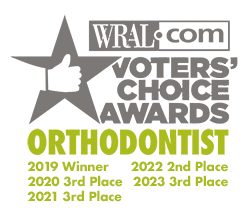Getting braces as an adult is much more common than you might think. Nearly one out of four orthodontic patients are now adults. There is no age limit to obtaining a beautiful, healthy smile.
Perhaps you’ve already had braces, but your teeth have drifted over the years. Maybe you needed orthodontic care but couldn’t get braces in adolescence. Whatever your case is, we’re here to help answer your questions about adult braces.
In this article, we’ll discuss varying factors when it comes to fixing your teeth as an adult:
Can Adults Get Braces?
Perhaps you’re in your 30s or 60s, wondering, “Can adults get braces?” The answer is yes, absolutely! Braces aren’t just for kids but for anyone of any age (provided you have permanent/adult teeth).
Whether you want to fix your overbite or close gaps in your teeth, getting adult braces benefits you beyond the aesthetics of a pretty smile. They can help you avoid long-term problems, such as receding gums, decaying teeth, gum disease, and difficulty chewing.
Why Consider Braces as an Adult?
You might wonder, “Isn’t braces something only teens deal with?” Well, think again! There are several reasons why adults opt for orthodontic treatment:
- Improved Oral Health: Misaligned teeth can lead to serious issues like tooth decay, gum disease, and jaw pain.
- Boosted Confidence: A straighter smile can enhance your self-esteem and social interactions.
- Corrective Needs: Some adults may need braces to fix issues that were not addressed in childhood or have developed over time.
- Advancements in Orthodontics: With modern technology, treatments are more discreet and comfortable than ever before.
Cost of Braces for Adults
The cost of braces for adults can vary widely, depending on the type of braces you choose, how long you will need to wear them, and where you are located. Everyone has a unique set of teeth. Jaw structure, size of teeth, bite placement, and sleeping/chewing patterns can all affect your projected overall cost.
Throughout the United States, you can generally estimate that adult braces cost between two to seven thousand dollars. Scheduling a consultation with your orthodontist will help you better understand your needs and which type of adult braces will work best for you.
Types of Braces for Adults
One of the benefits of getting braces in the 21st century is that there are so many more options than just the metal brackets of the 80s and 90s. The types of braces for adults are plentiful, and all are unique. Let’s delve into your options.
Metal Braces
Traditional braces consist of surgical-grade stainless steel brackets affixed to your teeth for the duration of your treatment. Wire runs through each bracket, wrapped with small rubber bands, helping the orthodontist efficiently align your teeth. While this is the most visible option, it’s also one of the most popular. Metal braces are nowhere near the size they used to be, and they are still one of the most effective and affordable methods of correcting tooth alignment.
If you’re looking for a relatively fast, affordable way to correct your teeth, metal braces may be for you.
Ceramic Braces
Like metal braces, ceramic braces are attached to your teeth throughout treatment. The difference is that the brackets are made of clear or tooth-colored ceramic, making them much less noticeable. However, ceramic braces are more fragile than their stainless-steel counterparts, which poses a risk of breakage and higher overall cost.
Should they break, there may be an extra cost of additional orthodontist visits and possible bracket replacement. Ceramic braces might work well for you if budget is less of a concern than the brackets’ visibility.
Lingual Braces
As the name implies, lingual braces are attached to your teeth facing inward, toward your tongue. The same materials as metal braces are used and they will be attached for the duration of your treatment. The difference is that there is virtually no visibility of your braces. While this is a great option for those conscientious of exposed brackets, it is a less common type of braces for adults and kids alike. The reason being: lingual braces aren’t for everyone, and their positioning alongside the tongue can be uncomfortable. In addition, dental hygiene– such as flossing– can be difficult.
If your orthodontic correction isn’t extensive, and you don’t want outward-facing brackets, lingual braces may be your solution. Consult your orthodontist; relatively few patients are good candidates for this solution.
Clear Aligners
Clear aligners have rapidly gained popularity, especially with adults, as they are virtually invisible and provide more flexibility than affixed brackets. Functioning much like mouthguards, they should be worn at least 20 hours daily. This form of adult braces is highly beneficial, as they can be removed at any time, such as during an important meeting or lunch with clients. In addition, hygiene maintenance is much simpler.
Typically, each aligner will be worn for a week, then replaced with the next, eventually shifting teeth to their optimal position. Clear aligners like Invisalign are an excellent alternative to traditional metal brackets. They will provide optimal results in the same time frame when used correctly.
One of the downsides of clear aligners is that it is completely up to the wearer to ensure that they’re worn as instructed. In order to produce optimal results, they should be worn between 20 to 22 hours a day. The length of treatment will depend on the complexity of the bite problem and amount of tooth movement needed, and is often similar to the length of treatment with traditional braces. If you are self-disciplined and committed to wearing your aligners for the majority of the day, every day, then this could be the option for you.
Please note that your orthodontist may not recommend clear aligners depending on what orthodontic work you need. For example, patients with severe bit misalignment or overcrowded teeth may benefit more from metal braces. Another factor to consider with clear aligners is that they often cost more than traditional methods.
Selecting the type of braces you want can be a complex process, but we’re here for you every step of the way.
How Long Do Adults Wear Braces?
One of the main questions we get is, “How long do braces take to straighten teeth for adults?”
The answer: Adult teeth tend to move at the same rate as children’s teeth, but the length of treatment varies, as everyone’s teeth are different. Treatment will be unique for each individual based on their current dental situation and ultimate goal. For example, if you’ve had braces before and have minor issues, you may only need braces for six months.
According to the American Association of Orthodontics, if you’re getting braces for the first time as an adult, treatment on average, may last about 22 months. Everyone’s dental state is different, but the more committed you are to wearing and taking care of your braces or aligners, the better result you’ll get in less time.
Myths About Getting Braces as an Adult
Way too many people have been convinced that getting braces as an adult is a bad idea. Not only is this deceptive, it can also prevent you from obtaining the orthodontic care you may need.
Let’s take a look at some of these myths about getting braces as an adult:
I’m too old for effective orthodontic treatment.
Like many things in life, age is just a number– and one you should be proud of! You are never too old to achieve the results you want, and adult braces are just as effective as kid braces. In addition, your maturity and dedication to getting the most out of your treatment will make the process that much more successful.
Straightening my teeth is just cosmetic.
Having a beautiful smile does give you confidence and boost your self-esteem. However, straightening your teeth can also improve your health by:
- Alleviating headaches and jaw tension
- Preventing excess wear on teeth
- Making your teeth less likely to chip
- Slowing down or stopping gum recession
- Helping you chew and speak correctly
- Reducing the likelihood of cavities
Metal braces are my only option.
As we discussed above, many different options are available to you that perhaps didn’t exist when you were a child. Getting braces as an adult is more convenient than ever because you can play an active role in choosing your treatment. We are happy to discuss whether porcelain brackets, lingual braces, or clear aligners would fit you well.
Getting braces as an adult is inconvenient.
Technological advances like 3D scanners make starting your orthodontic plan easier than ever. Because we can project your results before beginning your treatment, we can better supervise your progress. While you will have to come in for adjustments, the total number of appointments is much lower than it used to be thanks to the use of super-elastic archwires and plastic aligners. Getting braces as an adult is a straightforward process with the overall length of treatment being no different than orthodontic treatment of pre-teens.
Insurance won’t cover my orthodontic treatments, or it’s simply too expensive.
As the health benefits of getting braces are being recognized more widely, many insurance companies are helping cover the costs. Most orthodontists offer affordable payment plans even if your insurance can’t help you. Speak with your insurance provider and orthodontist to see what works best for you and your budget.
Tips for Adults Getting Braces
- Maintain Good Oral Hygiene: Brush and floss regularly to prevent any issues.
- Follow Your Orthodontist’s Advice: Stick to the treatment plan and attend all appointments.
- Stay Positive: Remember the end goal—a beautiful, healthy smile.
- Consider Financing Options: Look into payment plans or dental insurance coverage to manage costs.
Get the Smile of Your Dreams
If you’re ready to explore your options, we are here for you. Located in Raleigh, North Carolina, our Walton & Maready Orthodontics team invites you in for a free consultation, including x-rays. Our experienced, professionally trained orthodontists will help you decide if adult braces suit you. We want to help you get the smile of your dreams!







